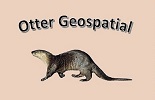At the beginning of the Fall 2020 semester, Dr Keir Wefferling expressed interest in “walking tours” as a way to locate plants and plant communities for the benefit of his Field Botany students. The Avenza Maps mobile app was chosen for conveying location information to students.
When we tackle something new like this we like to document our development work on the website. The upside of doing it this way is that our new learning is shared with users and colleagues in real time – especially handy if the work is disrupted unexpectedly. The downside is that the messiness of the development process is out there for all to see. In this case the process for creating and distributing the digital maps is bound to involve some trial and error. This version of the workflow includes changes thru 18-sep-2020.
Tour Leader Activities
The tour leader creates a map that shows the location of the tour stops against a background that makes sense to tour participants. The map is georeferenced i.e the features portrayed in the map are aligned with their real locations on the earth’s surface.
- The tour stop locations are defined by listing them in a table (csv is the preferred file format). The table includes the title, the latitude and the longitude of each tour stop.
- A number of software tools can be used to overlay the tour stop locations on a georeferenced base map. Our preferred method is to compose the map in ArcGIS Desktop and output it as a GeoPDF. We can draw on a library of hundreds of base maps but most often we use fairly recent aerial or satellite imagery.
- Verify that the map file is reasonable size (< 1 mb). The file output by ArcGIS is sometimes bloated for no apparent reason. As of August 2020 the most effective workaround is to run the file through the Reduce File Size tool in Adobe Acrobat.
- The map file is distributed to tour participants. There are many ways to accomplish this but as of August 2020 we are recommending that campus email be used. The method for moving an email attachment into the Avenza app is simple and well documented.
Tour Participant Activities (Setting Up the Mobile Device)
Students wishing to participate in the walking tour need to prepare their mobile device as follows:
- Download the free version of Avenza Maps from the App Store or Google Play
- Confirm that the mobile device that will be used for the walking tour is configured to receive UWGB campus email. See UKnowIT articles Campus Email – Setup on iOS and Campus Email Setup on Android.
Tour Participant Activities (Using the App)
Once Avenza Maps is on the mobile device, using it is pretty straightforward. The initial install includes a general purpose map that the user can play with and get a feel for observing their movement on the screen. It isn’t readily apparent, but the built-in map allows the user to switch from a street map to a satellite image similar to the way Google Maps behaves. Using the app for our walking tours involves loading custom maps which quickly puts us up against the free version’s three-map limit. Dealing with that limitation is inconvenient but manageable.
- Confirm that loading the walking tour map will not exceed the limit of three map files allowed by the free version of Avenza Maps. Do this by opening Avenza and viewing the list of map files currently in the app (My Maps filtered by All Items). Remove an unneeded map from the app by left-swiping on its title in the My Maps list.
- Participants should have received the walking tour map as an email attachment. Download it and export it to Avenza Maps as described at Importing maps from custom locations. Note that the map is described as having been imported into Avenza but it got there by being exported from the mobile device’s email inbox.
- Verify that the name of the walking tour map shows up in the My Maps list, select it and start walking
